There are no snakes in Alaska, but California makes up for it! Of the 46 different kinds of snakes in California, nine of them are dangerously poisonous (venomous). What kind of venomous snakes live in California? Where are all of these venomous snakes? Are they located in every county in California? How many people get bitten by venomous snakes in the state?
What’s the difference between venomous and poisonous? Technically, poison is something you eat, drink, or absorb through your skin. On the other hand, venom is forcibly injected into the body. In the case of snakes, by way of hollow or grooved fangs that puncture the skin so the venom can enter the blood stream.
But, that wasn’t always true! Until recently, the scientific literature used poisonous and venomous interchangeably. However, now that we know about updated terminology, we can learn all about these amazing venomous California snakes.
What kinds of snakes are venomous in California?
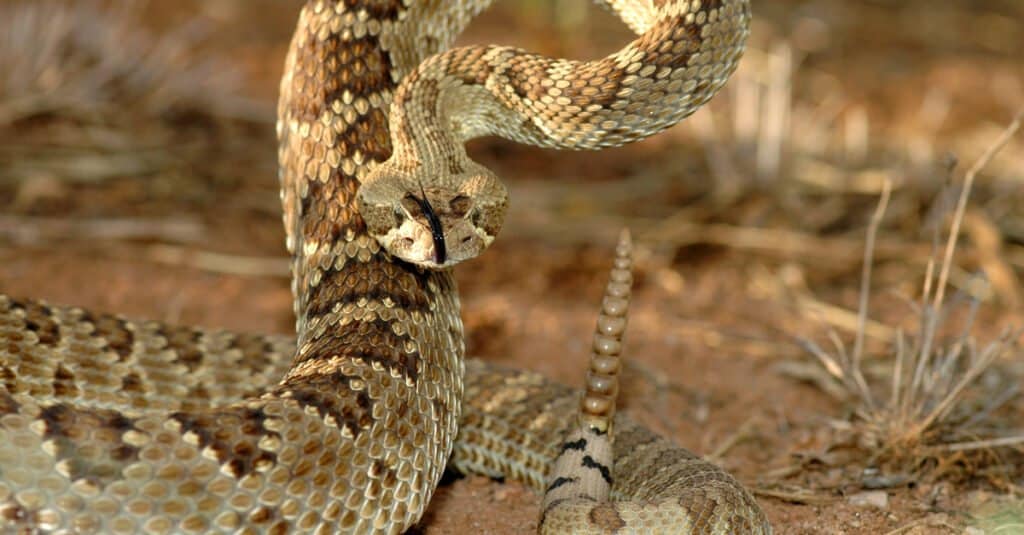
All of the venomous snakes in California are a kind of rattlesnake.
©Rusty Dodson/Shutterstock.com
All nine venomous snakes in California are rattlesnakes. They all have a triangle head, vertical slits for eyes (like cat eyes), and a rattle at the end of their tail to warn predators (and humans). They have venom glands that produce toxic venom that’s injected into the body, making them venomous. However, people still often refer to them as poisonous due to the harmful effects of their venom. Here are the nine snakes in California to be aware of.
1) Western Rattlesnake
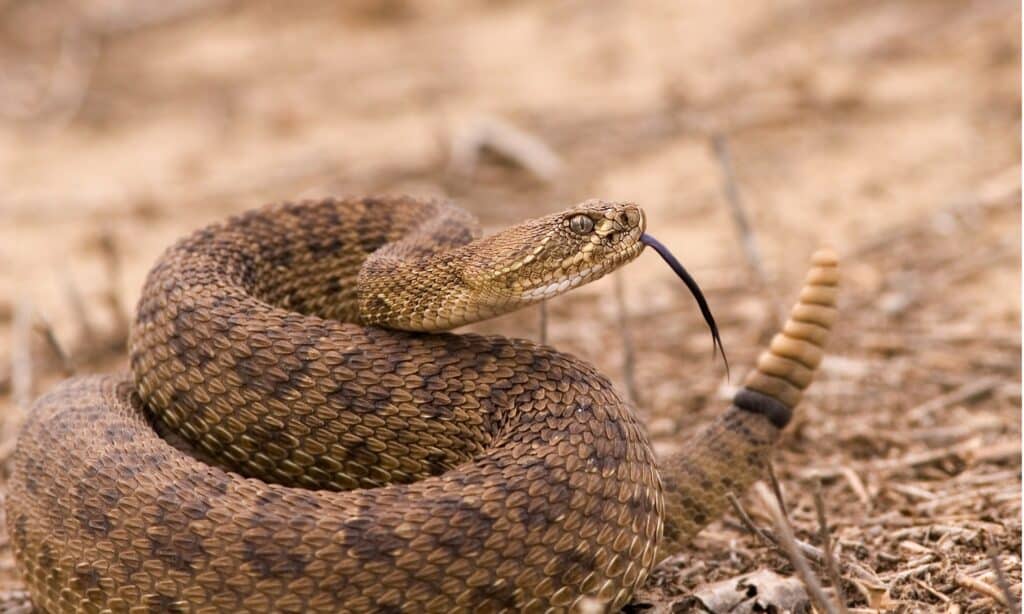
The Western rattlesnake is one of the few rattlesnakes you can find throughout the state.
©iStock.com/SteveMcsweeny
The Western rattlesnake is really three species now. Although they were all considered subspecies of Crotalus oreganus, modern testing showed otherwise. Now, we have three separate species including the northern Pacific rattlesnake, Great Basin rattlesnake and southern Pacific rattlesnake. The northern Pacific rattlesnake has the largest range of all the rattlesnakes in California and occurs from the northern border of the state down to the Los Padres National Forest area. These rattlesnakes are between four and six feet long and are heavy-bodied snakes. They tend to match their environment and range in different shades of brown, reddish brown, or tan with dark brown rounded markings and the typical triangular head. Their venom is more potent than most rattlesnakes, but they are not aggressive.
2) Western Diamondback Rattlesnake

They can deliver more venom with their large fangs and are one of the most poisonous snakes in California.
©Audrey Snider-Bell/Shutterstock.com
Similar to the Western rattlesnake, the Western diamondback has a diamond design along the length of its body. It delivers one of the most potent bites because it can deliver more venom with its large fangs in one bite. It is not found throughout the state, so you only need to be aware in the drier southeastern California, around San Diego and the southern border with Mexico, and the eastern border with Arizona. At four to five feet long with a large rattle, black and white bands at the tail, and a heavy-bodied snake, they are easy to identify. Besides, they rattle at the drop of a hat. You’ll probably hear it first.
3) Red Diamond Rattlesnake
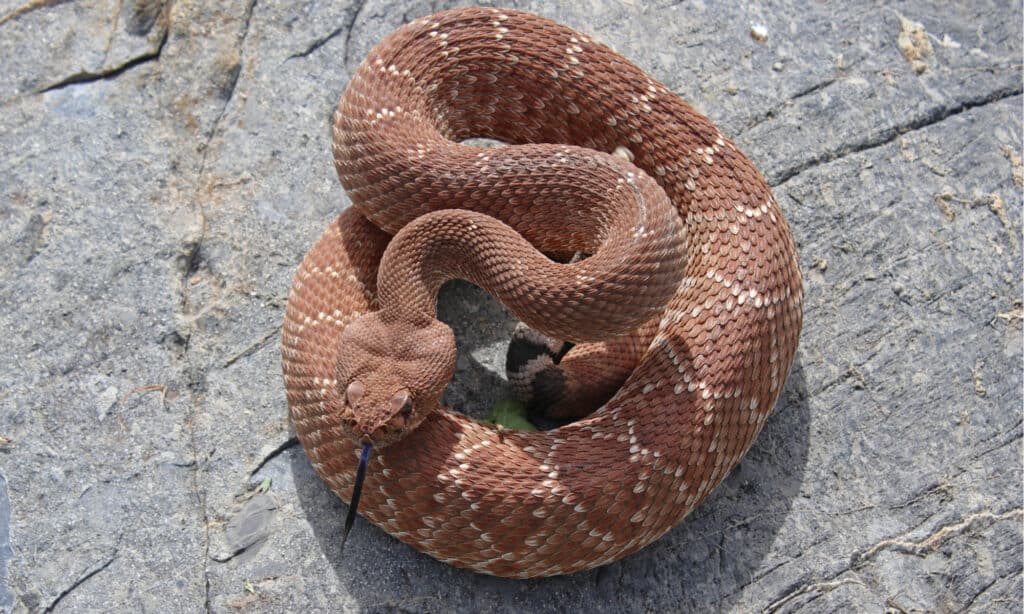
Red Diamond rattlesnakes have a reddish-brown color and a black and white striped tail.
©Creeping Things/Shutterstock.com
The Red Diamond rattlesnakes can only be found in the far southwest corner of California, not throughout the state. They have unique coloration and markings. They look similar to the Western diamondback, but the diamond shapes have a reddish-brown tint. Like the western diamondback, the last few inches of their tail, before the rattle, has zebra-like black and white stripes. Most are two to four and a half feet long and are venomous, so be careful if you see the black and white stripes!
4) Southwestern Speckled Rattlesnake
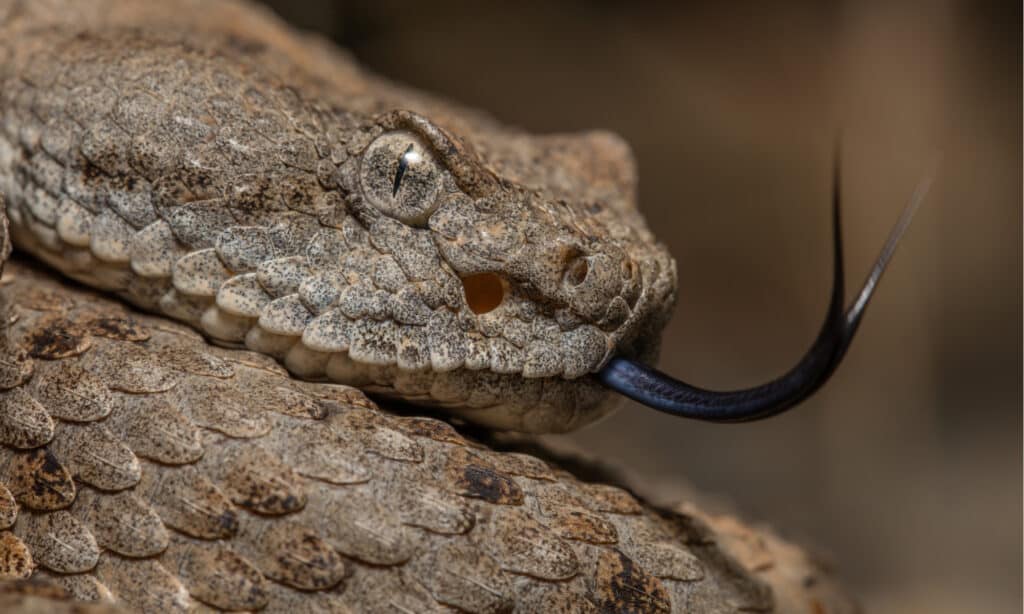
The Southwestern speckled rattlesnake has two “pits” on the side of its head for sensing prey.
©Alexander Wong/Shutterstock.com
These medium-sized snakes are located in the southwestern part of the United States but the southeastern part of California (they are also in Nevada). The southwestern speckled rattlesnake gets its name from the speckled appearance of browns, blacks, and tan speckled banding. It can be 2-3.5 feet long and is a heavy-bodied snake. Like other rattlesnakes, it gives fair warning to predators or humans and will coil, use its rattle and rise showing its fangs as a warning before striking. It is venomous so keep your distance from it.
5) Mojave Rattlesnake

The Mojave rattlesnakes are typically 2-4 feet long and are large-bodied snakes.
©Creeping Things/Shutterstock.com
The Mojave rattlesnakes looks similar to the western diamondbacks and have the black and white stripes by the tail like the red diamond rattlesnakes. They are typically two to four feet long and large-bodied snakes. In California, they are only in the Mojave Desert in the south eastern part of the state. Since there are fewer people that live in and/or visit the desert, there are fewer human-Mojave conflicts.
6) Panamint Rattlesnake
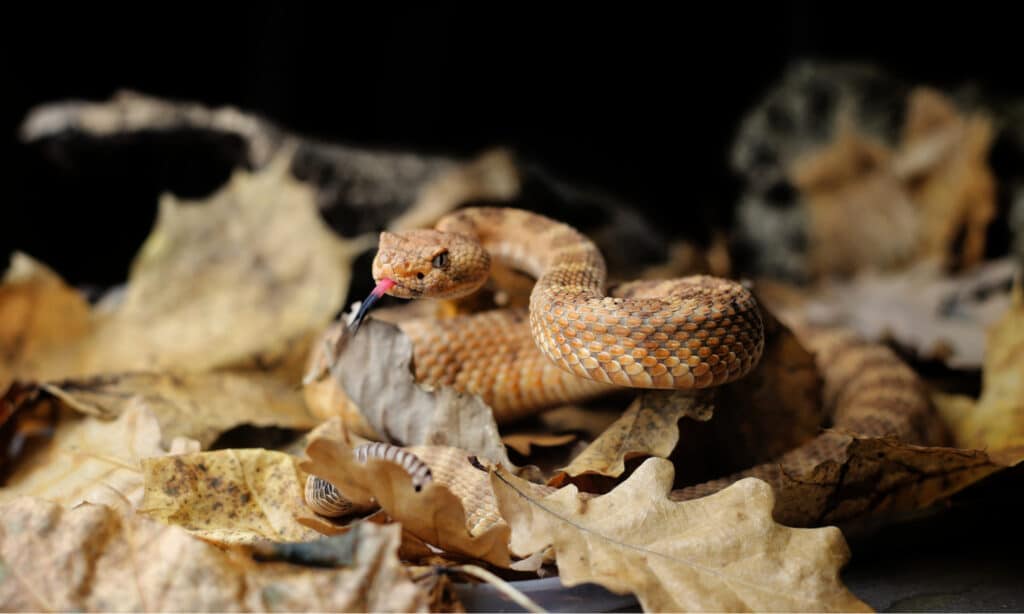
The Panamint rattlesnake lives in the mountains in south east California.
©Marina Kehl/Shutterstock.com
Panamint rattlers are pretty much the same coloration from head to tail but can have some variations. They are typically brown, yellowish, or tan with lighter markings. In California, they prefer the rocky mountainous habitats, living in the south eastern part of the state. They grow to be two to four and a half feet long and are venomous, but bites are rare. Panamint City is an old town that is a ghost town now in the Panamint Mountains of Death Valley.
7) Sidewinder

Sidewinders move through the sand in an S-motion and can slither up to 18 mph.
©Roger de Montfort/Shutterstock.com
The Sidewinder is fascinating to watch! It slithers from side to side in an S-motion to move from place to place, and it can move fast. Its unique propulsion can get up to 18 miles per hour. If onewouldn’t chase you, you wouldn’t be able to outrun it, but Sidewinders are not aggressive and do not chase people. They are a bit smaller, around 2-2.5 feet, and although they are venomous, their bites only deliver a small amount of venom. In California, you will only find them in the Sonoran desert in the southern part of the state.
Where do most venomous snake bites occur in California?
Most snake bites in California occur in Southern California. If you mapped out the locations of the snakes on our list, you would see that most are in the southern part of the state.
When do most venomous snake bites occur in California?
Most snake bites occur between April – October, when snakes are more likely to come out and sun themselves in the warmer weather.
Do a lot of people get bitten by snakes in California?

With proper medical treatment, including antivenin, bites are usually not serious.
©Maria Dryfhout/Shutterstock.com
The California Poison Control System reports an average of 300 cases in a year, with more incidents being reported by emergency rooms and medical facilities. In the US, there is an average of 7,000-8,000 venomous snake bites per year.
As you saw on our list, most of the rattlesnakes live in remote areas like deserts and mountains, so the number of human/rattlesnake encounters is relatively small. An article in the Natural History Museum of Los Angeles stated that our fear of being bitten by snakes is misplaced when we look at the statistics. North Carolina actually has the highest snake-bite rate in the country.
How can you prevent being bit by a venomous snake?
Here are a few tips to keep safe if you are in an area with venomous snakes:
1. Wear boots and long pants.
2. Stay on marked trails.
3. If you come across a snake, do not handle it. Walk away slowly.
4. Don’t hike alone, and stay on the trails.
5. Don’t pick up rocks, logs, or firewood without looking for snakes first, remember they can be camouflaged.
6. Teach children to leave snakes alone and not to pick them up.
What should you do if you get bitten by a snake?
If you get bit by a snake, you should seek immediate medical attention. You may not know what kind of snake it was, and it is safest to get help. Do not try to catch the snake to help identify it. If possible, take a photo or memorize color and pattern to help medical staff. Just leave the area and find the closest medical facility. In the US, we are lucky to have trained professionals and antivenom that help keep the fatality rate from snake bites very low. According to the CDC, of the 7,000-8,000 venomous snake bites in the US, only an average of five are fatal.
Bonus: Which State Is the Most Snake-Infested in the U.S.?

Your chances of encountering a venomous or nonvenomous snake will depend on which state you live in. Three U.S. states actually have no snakes at all–Alaska, Hawaii, and Maine. There are definitely some states where snakes seem to dominate in terms of species and numbers.
What state ranks highest for being snake-infested? That would be Texas, with a whopping 68 snake species! Venomous snakes in the state are several rattlesnake species, copperheads, cottonmouths, and Texas coral snakes. Nonvenomous snakes include the Texas indigo, Texas brown snake, Texas blind snake, and one of the most numerous–the Texas rat snake. The greatest concentration of snakes is in central Texas.
The top 10 most snake-infested states are as follows:
| Rank | State | # of Species |
|---|---|---|
| 1 | Texas | 68 |
| 2 | Arizona | 52 |
| 3 | Nevada | 52 |
| 4 | Louisiana | 48 |
| 5 | Missouri | 47 |
| 6 | New Mexico | 46 |
| 7 | Oklahoma | 46 |
| 8 | Georgia | 46 |
| 9 | Florida | 44 |
| 10 | Alabama | 43 |
The photo featured at the top of this post is © Alexander Wong/Shutterstock.com
Discover the "Monster" Snake 5X Bigger than an Anaconda
Every day A-Z Animals sends out some of the most incredible facts in the world from our free newsletter. Want to discover the 10 most beautiful snakes in the world, a "snake island" where you're never more than 3 feet from danger, or a "monster" snake 5X larger than an anaconda? Then sign up right now and you'll start receiving our daily newsletter absolutely free.
Thank you for reading! Have some feedback for us? Contact the AZ Animals editorial team.






